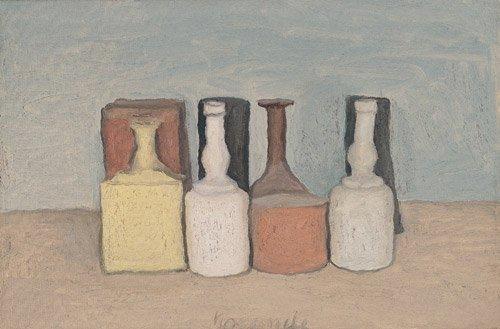A still life is a work of art depicting mostly inanimate subject matter, its origins are found in the Middle Ages and ancient Greco-Roman art, it was first seen in Western art in the early 16th. century when the paintings often contained religious and allegorical symbolism relating to the objects depicted, we see how these objects lose their domestic purpose to become sculptural objects ‘that may invite meditation and contemplation’, we slow down and focus when looking at them.
Morandi solved the problem of ambiguity in meaning, i.e. domestic objects or motifs in art, reaching an integration that gives the objects new meaning, it is possible to give new meaning to most works of art , some artists are more skillful than others in conveying what they wish to express, some art critics interpret the intention in the work in a way the artist has not. ‘His work ( Morandi) is not about depicting the solidity of objects but rather interpreting them as a metaphor of light, space, body and time’ I think this is so, others may disagree.
Georgio Morandi was born in Bologna, Italy, he spent most of his life living with his mother and sisters, he had a second home in the Appenines. He studied for six years at the Academia de Belle art in Bologna, He was aware of paintings by Giotto, Massaccio, Uccelli and Monet and very much admired the work of Cezanne, whose use of geometric shapes, like the cube and cylinder, when painting landscapes and still lifes, was to influence his own work. He knew Futurist painters and writers and exhibited work with them, also Surrealist painters like de Chirico, although he didn’t share their philosophy. He didn’t travel abroad until 1956 and then he did not go to Paris, the hub of artistic creativity at the time.
In this still life which Morandi painted in 1956, he arranged eight objects in two lines, the colours are beautifully muted, he did at times use the earthy colours of his native Bologna. He wrote ‘The only interest the visible world awakens in me concerns space, colour and forms’, as mentioned earlier, these themes crop up often when describing his work, he uses these elements to transform what he sees into what he paints, so we see how he places his objects, chooses the colour and creates new shapes, groups of objects create new boundaries. Some critics have been critical of Morandi for using the objects over and over again while others write that the objects ‘are not there at all.’ His work oscillates between figurative and abstract, it ‘is elusive as well as self revealing’ and as mentioned earlier sometimes his objects overlap or are grouped in blocks, so that a contour becomes a boundary shared by two or more objects.
Looking at his work we can sense a stillness, the groups are an island of calm , the bowl, bottle or pitcher provide their own stability and balance. One art critic wrote ‘In the limitation of Morandi’s motifs appears the abundance of his world.’ He successfully remained focused on very familiar objects for many years just as Cezanne had painted the same mountain time and time again. Space became indistinguishable from the object. George Lakoff describes it as ‘in betweeness’ that also contains meaning. Looking at more of Morandi’s work would be of help to see how he creates a variety of shapes gained from the same objects, I enjoy turning his paintings upside down to see the objects/spaces from a new angle. He was an excellent draughtsman and left a large body of work in many media – oils, watercolours, drawings and etchings.
en.wikipedia.org/wiki/Giorgio_Morandi

